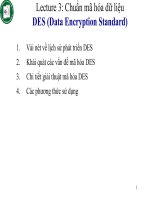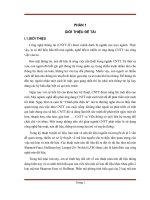Mã nén Lecture_1
Bạn đang xem bản rút gọn của tài liệu. Xem và tải ngay bản đầy đủ của tài liệu tại đây (170.62 KB, 27 trang )
1
Introduction to Data Compression
Data compression seeks to reduce the number of bits used to
store or transmit information.
2
Lecture 1
Source Coding
and Statistical Modeling
Alexander Kolesnikov
Entropy
Example
How to get probailities
Shannon-Fano code
Huffman code
Prefix codes
Context modeling
3
Entropy
Set of symbols (alphabet) S={s
1
, s
2
, …, s
N
},
N is number of symbols in the alphabet.
Probability distribution of the symbols: P={p
1
, p
2
, …, p
N
}
According to Shannon, the entropy H of an information
source S is defined as follows:
∑
=
⋅−=
N
i
ii
ppH
1
2
)(log
4
Entropy
The amount of information in symbol s
i
,
in other words, the number of bits to code or code length
for the symbol s
i
:
)(log)(
2 ii
psH −=
∑
=
⋅−=
N
i
ii
ppH
1
2
)(log
The average number of bits for the source S:
5
Entropy for binary source: N=2
))1(log)1(log(
22
ppppH
−⋅−+⋅−=
S={0,1}
p
0
=p
p
1
=1-p
0 1
p
1-p
H=1 bit for p
0
=p
1
=0.5
6
Entropy for uniform distribution: p
i
=1/N
Uniform distribution of probabilities: p
i
=1/N:
)(log)/1(log)/1(
2
1
2
NNNH
N
i
∑
=
=⋅−=
Examples:
N= 2: p
i
=0.5; H=log
2
(2) = 1 bit
N=256: p
i
=1/256; H=log
2
(256)= 8 bits
P
i
=1/N
s
1
s
2
s
N
7
How to get the probability distribution?
1) Static modeling:
a) The same code table is applied to all input data.
b) One-pass method (encoding)
c) No side information (không cần thông tin phụ)
2) Semi-adaptive modeling:
a) Two-pass method: (1) analysis and (2) encoding.
b) Side information needed (model, code table)
3) Adaptive (dynamic) modeling:
a) One-pass method: analysis and encoding
b) Updating the model during encoding/decoding
c) No side information
8
Static vs. Dynamic: Example
S = {a,b,c}; Data: a,a,b,a,a,c,a,a,b,a.
1) Static model: p
i
=1/10
H = -log
2
(1/10)=1.58 bits
2) Semi-adaptive method: p
1
=7/10; p
2
=2/10; p
3
=1/10;
H = -(0.7*log
2
0.7 + 0.2*log
2
0.2 + 0.1*log
2
0.1)=1.16 bits
9
3) Adaptive method: Example
S = {a,b,c}; Data: a,a,b,a,a,c,a,a,b,a.
Symbol 1 2 3 4 5 6 7 8 9 10
a 1 2 3 3 4 5 5 6 7 7
b 1 1 1 2 2 2 2 2 2 3
c 1 1 1 1 1 1 2 2 2 2
Pi 1/3 2/4 1/5 3/6 4/7 1/8 5/9 6/10 2/11 7/12
0.33
0.5 0.2 0.5 0.57 0.13 0.56 0.60 0.18 0.58
H 1.58 1.0 2.32 1.0 0.81 3.0 0.85 0.74 2.46 0.78
H=(1/10)(1.58+1.0+2.32+1.0+0.81+3.0+0.85+0.74+2.46+0.78)
=1.45 bits/char
1.16 < 1.45 < 1.58
S.-Ad. Ad. Static
10
Shannon-Fano Code: A top-down approach
1) Sort symbols according their probabilities:
p
1
≤ p
2
≤ … ≤ p
N
2) Recursively divide into parts, each with approx. the same
number of counts (probability)









